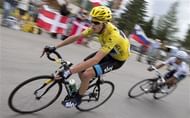Cycling to Lance Armstrong is what the two hydrogen molecules are to water. Both not only gel perfectly well with each other, but also can’t exist without each other. If people across the globe remember Lance today, it is either because of his lying spree, which saw its climax at the Opera Winfery show, or the laurels that the sport of cycling gave him. In this segment of the Sportskeeda year-ender collection, let’s look into some of the noteworthy moments, which along with shaking the world also taught us the age old lesson that ‘None can be trusted.’
Almost every year the game of cycling elevates our interest at the end of July when the best peddlers in the world arrive in France to part take in the prestigious Tour De France. However, the year 2013 was different. By mid-January, Armstrong turned into the topic of discussion among sports enthusiasts all across the world. This was after the former Tour De France champion finally accepted what everyone already knew, that he had been a drugs cheat throughout his career.
Accepting an invitation from the famous chat-show host Oprah Winfrey, the Austin boy made a rather grim admission that he had taken doping products, notably the blood-booster EPO, in all seven of his Tour de France successes, of which he had already been stripped by the US Anti-Doping agency (USADA).
If one thinks that Armstrong was the only one who suffered the maximum damage due to this saga, then we beg to differ as the subsequent federal inquiry followed by a USADA investigation promised to cast a shadow over the entire season. It was proved to be true as the British paddler Chris Froome‘s domination at the greatest race was accompanied by a steady stream of unsavoury speculation. Time and again, Froome was forced to answer questions about doping, about whether he was involved in the same and if cycling could emerge from its tainted past into a bright new, and clean future.
The Brit himself was majestic, winning the Grand Boucle by more than four minutes ahead of the talented Colombian climber Nairo Quintana. After claiming the Yellow Jersey after the stage nine following his imperious victory up Ax3 Domaines, it was his gritty determination, which ensured that he stood the relentless attacks launched by specially Movistar team, whose leader Alejandro Valverde would eventually be eclipsed by younger statesman Quintana.
If everything culminated into a fine year for Froome in which he won the Tour of Oman, Criterium International, Tour de Romandie and Criterium du Dauphine, while finishing second in the Tirreno-Adriatico, it was a polar opposite year for Wiggins, who had decided to take on the Giro d’Italia, only to be forced to withdraw after stage 12, following a miserable race in which a crash and a puncture had lost him time, that eventually culminated in defeat.
He pulled out of his Tour de France defence due to injury and focused on the World Championships time-trial. Although he was dominant in that discipline the previous year winning gold at the Olympics, this time he finished second to Tony Martin, who won for the third year in a row.
The year is done and we believe, so is the Armstrong saga. As the new year awaits, we believe that the sport of cycling will see a bright future with peddlers coming out with rejuvenated spirits to compete at the highest level of the game.

